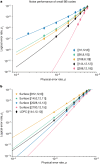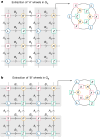High-threshold and low-overhead fault-tolerant quantum memory
- PMID: 38538939
- PMCID: PMC10972743
- DOI: 10.1038/s41586-024-07107-7
High-threshold and low-overhead fault-tolerant quantum memory
Abstract
The accumulation of physical errors1-3 prevents the execution of large-scale algorithms in current quantum computers. Quantum error correction4 promises a solution by encoding k logical qubits onto a larger number n of physical qubits, such that the physical errors are suppressed enough to allow running a desired computation with tolerable fidelity. Quantum error correction becomes practically realizable once the physical error rate is below a threshold value that depends on the choice of quantum code, syndrome measurement circuit and decoding algorithm5. We present an end-to-end quantum error correction protocol that implements fault-tolerant memory on the basis of a family of low-density parity-check codes6. Our approach achieves an error threshold of 0.7% for the standard circuit-based noise model, on par with the surface code7-10 that for 20 years was the leading code in terms of error threshold. The syndrome measurement cycle for a length-n code in our family requires n ancillary qubits and a depth-8 circuit with CNOT gates, qubit initializations and measurements. The required qubit connectivity is a degree-6 graph composed of two edge-disjoint planar subgraphs. In particular, we show that 12 logical qubits can be preserved for nearly 1 million syndrome cycles using 288 physical qubits in total, assuming the physical error rate of 0.1%, whereas the surface code would require nearly 3,000 physical qubits to achieve said performance. Our findings bring demonstrations of a low-overhead fault-tolerant quantum memory within the reach of near-term quantum processors.
© 2024. The Author(s).
Conflict of interest statement
US Patent Application 18/527304 (filed on 3 December 2023 and naming S.B., A.W.C., J.M.G., D.M., P.R., Kevin Tien and T.J.Y. as co-inventors) contains technical aspects from this paper.
Figures





References
-
- Wu, Y., Wang, S.-T. & Duan, L.-M. Noise analysis for high-fidelity quantum entangling gates in an anharmonic linear Paul trap. Phys. Rev. A97, 062325 (2018).10.1103/PhysRevA.97.062325 - DOI
-
- Boguslawski, M. J. et al. Raman scattering errors in stimulated-Raman-induced logic gates in 133Ba+. Phys. Rev. Lett.131, 063001 (2023). - PubMed
-
- Nielsen, M. A. & Chuang, I. Quantum Computation and Quantum Information (Cambridge Univ Press, 2002).
LinkOut - more resources
Full Text Sources
Other Literature Sources

